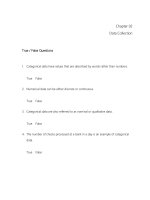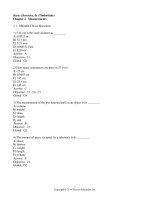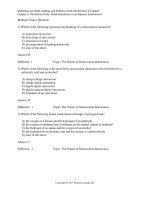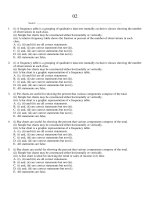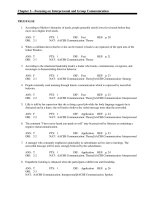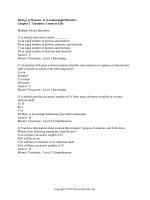Microbiology with diseases by taxonomy 4th edition bauman test bank
Bạn đang xem bản rút gọn của tài liệu. Xem và tải ngay bản đầy đủ của tài liệu tại đây (236.54 KB, 10 trang )
MULTIPLE CHOICE. Choose the one alternative that best completes the statement or answers the question.
1) Which of the following is a particle found in the nucleus of an atom and that has no electrical
1) _______
charge?
A) neutron
B) isotope
C) element
D) electron
E) proton
2) Matter composed of a single type of atom is known as a(n)
A) element.
B) mineral.
C) electron.
D) compound.
E) molecule.
2) _______
3) A stable atom has ________ in its valence shell.
A) 8 electrons
B) 8 protons
C) 2 neutrons
D) 10 electrons
E) 4 electrons
3) _______
4) Which parts of the atoms interact in a chemical reaction?
A) isotopes
B) neutrons
C) protons
4) _______
D) ions
5)
E) electrons
5) _______
The outer ring in Figure 2-1 represents
A) the nucleus.
B) an electron.
C) an isotope.
D) a neutron.
E) an electron shell.
6) The valence of an atom represents its
A) electronegativity.
B) ability to interact with other atoms.
C) radioactivity.
D) ability to interact with water.
E) ability to attract electrons.
6) _______
7) The type(s) of bond produced when atoms share electrons equally is/are
A) an ionic bond.
B) a nonpolar covalent bond.
C) a hydrogen bond.
D) a polar covalent bond.
E) both polar covalent and ionic bonds.
7) _______
8) The type(s) of bond produced when atoms with somewhat different electronegativities share
electrons is/are
A) a polar covalent bond.
B) an ionic bond.
C) a nonpolar covalent bond.
D) a hydrogen bond.
E) both nonpolar covalent and ionic bonds.
8) _______
9) Which of the following types of chemical bonds do carbon atoms generally NOT form?
A) polar covalent bonds
B) ionic bonds
C) hydrogen bonds
D) nonpolar covalent bonds
E) neither ionic nor hydrogen bonds
9) _______
10) Unstable isotopes can be useful
A) in the formation of hydrogen bonds.
B) catalysts.
C) in vitamins.
D) in medical diagnosis.
E) as buffers.
10) ______
11) Which of the following is an INCORRECT pairing?
A) hydrolysis; hydrogen bonds
B) dehydration; anabolism
C) catabolism; exothermic
D) synthesis; endothermic
E) electrolytes; anions
11) ______
12) Compounds that readily dissociate in water are
A) ionic.
B) polar.
C) nonpolar.
D) either polar or ionic.
E) never polar or ionic.
12) ______
13) Which of the following is a property of water?
A) It is a nonpolar molecule.
B) It has a high capacity for heat.
C) It is not a good solvent.
D) It is liquid in a very narrow temperature range.
E) It is not a common reactant in metabolic reactions.
13) ______
14) An acid dissociates in water to release
A) hydroxyl group(s).
B) anion(s).
C) cation(s).
D) hydrogen ion(s).
E) both anions and hydrogen ions.
14) ______
15) The reverse of a dehydration synthesis reaction is a(n) ________ reaction.
15) ______
A)
B)
C)
D)
E)
anabolic
endothermic
exchange
metabolic
hydrolytic
16) A hydroxyl ________ acts as a base.
A) salt
B) group
16) ______
C) anion
D) atom
E) cation
17) Which of the following is NOT a characteristic of saturated fats?
A) Their fatty acids pack tightly together.
B) They are found in animals.
C) They contain at least one double bond.
D) They are a form of stored energy.
E) They are usually solid at room temperature.
17) ______
18) Which of the following is NOT a characteristic of phospholipids?
A) They contain fatty acids that associate with water.
B) They can form micelles and bilayers.
C) They contain two fatty acids and a phosphate functional group.
D) They contain a hydrophilic phosphate "head."
E) They are found in cellular membranes.
18) ______
19) Organisms use carbohydrates in all of the following ways EXCEPT
A) as a building block of DNA and RNA molecules.
B) as a long-term energy source.
C) to keep membranes flexible at low temperatures.
D) as a component of cell walls.
E) as a short-term energy source.
19) ______
20) Nucleic acids, proteins, and complex carbohydrates are all produced by
A) dehydration synthesis.
B) exchange reactions.
C) hydrogen bonding.
D) hydrolytic reactions.
E) catabolic reactions.
20) ______
21) Which of the following is an example of a polysaccharide?
A) glycogen
B) fructose
C) glucose
D) sucrose
E) deoxyribose
21) ______
22) Which of the following statements about proteins is FALSE?
A) They are formed by dehydration synthesis reactions.
B) They are composed of amino acids.
C) They can be hydrophobic, hydrophilic, or both.
D) Their primary function is energy storage.
E) They have multiple levels of structural organization.
22) ______
23) All of the following are components of an amino acid EXCEPT a(n)
23) ______
A)
B)
C)
D)
E)
carboxyl group.
pentose group.
amino group.
R group.
α-carbon.
24) Which of the following is found in nucleic acids?
A) carboxylic acid
B) purines
C) glycerol
D) R group
E) amines
24) ______
25) Hydrogen bonds are found in all of the following EXCEPT
A) in the DNA double helix between nucleotides.
B) between the R groups of amino acids in proteins.
C) in α-helices.
D) between water molecules.
E) between phosphates in ATP.
25) ______
26) Tertiary and quaternary structure of proteins involves ________ bonds.
A) ionic
B) nonpolar covalent
C) polar covalent
D) hydrogen
E) ionic, hydrogen, polar, and nonpolar covalent
26) ______
27) Which of the following are examples of pyrimidines?
A) cytosine and guanine
B) cytosine and thymine
C) uracil and adenine
D) thymine and guanine
E) thymine and adenine
27) ______
28) All of the following bases are found in RNA molecules EXCEPT
A) guanine.
B) adenine.
C) thymine.
D) uracil.
28) ______
E) cytosine.
29) The "backbone" of the DNA molecule is composed of
A) pentoses.
B) phosphates.
C) amino acids.
D) alternating phosphates and pentoses.
E) nitrogenous bases.
29) ______
30) Which of the following would NOT normally be found as a component of a cell's nucleic acids?
A) cytosine ribonucleotides
B) adenine deoxyribonucleotides
C) adenine ribonucleotides
D) thymine deoxyribonucleotides
E) uracil deoxyribonucleotides
30) ______
31) All of the following are associated with ATP molecules EXCEPT
31) ______
A)
B)
C)
D)
E)
high-energy bonds.
a recyclable energy supply.
a long-term energy supply.
formation of coenzymes.
three phosphate groups.
32) Which of the following statements concerning nucleic acids is FALSE?
A) Cytosine is found in all nucleic acid molecules.
B) Not all DNA is double stranded.
C) Nucleic acid strands are held together by hydrogen bonds between complementary bases.
D) The nucleic acid polymer is composed of peptide bonds.
E) Some viruses have DNA as their genomes.
32) ______
33) Which of the following is an INCORRECT pairing?
A) secondary structure; β-pleated sheets
B) secondary structure; disulfide bridges
C) primary structure; amino acid sequence
D) tertiary structure; covalent bonds
E) quaternary structure; two or more polypeptides
33) ______
34) Proteins contain both acidic and basic R groups, and can therefore function as
A) catalysts.
B) structural macromolecules.
C) energy storage macromolecules.
D) buffers.
E) genetic material.
34) ______
35) A(n) ________ is a compound that dissolves into anions and cations in water.
A) salt
B) buffer
C) acid
D) catalyst.
35) ______
E) base
36) Plant cell walls are composed of ________ held together by ________.
A) polysaccharides; hydrogen bonds
B) amino acids; peptide bonds
C) fatty acids; polar covalent bonds
D) peptidoglycan; ionic bonds
E) disaccharides; hydrophobic interactions
36) ______
37) A(n) ________ is an arrangement of atoms found in a variety of macromolecules.
A) salt
B) functional group
C) buffer
D) isotope
E) stereoisomer
37) ______
38) Decomposition reactions are commonly ________ reactions.
A) anabolic
B) exchange
C) endothermic
D) exothermic
E) dehydration
38) ______
39) Lipids found in the membranes of all eukaryotic cells are
39) ______
A)
B)
C)
D)
E)
phospholipids.
waxes.
steroids.
triglycerides.
polyunsaturated fats.
40) A protein is a ________ of amino acids.
A) bilayer
B) polymer
C) decomposition product
D) monomer
E) solution
40) ______
41) DNA is composed of repeating units of sugars, phosphates, and nucleic acids. This is an example
of a
A) micelle.
B) polymer.
C) salt.
D) lipid.
E) monomer.
41) ______
42) A polymer composed of simple sugars is a(n)
A) protein.
B) starch.
C) amino acid.
D) glycoprotein.
E) triglyceride.
42) ______
43) Anna is conducting an experiment using a pH indicator that is red at low pH, green at neutral
pH and purple at high pH. She starts with a green solution. When she adds compound X to her
solution it turns purple. Then she adds compound Z to the solution and it turns green. She adds
more Z, the solution remains green. These observations suggest X is ________ and Z is ________.
A) a base; a strong acid
B) a base; a buffer
C) a buffer; a base
D) an acid; a base
E) an acid; a buffer
43) ______
44) An amine group is removed from an amino acid and bonded to a second compound to form a
different amino acid. No other molecules are used or produced. What type of reaction is likely to
be involved?
A) a decomposition reaction
B) a synthesis reaction
C) a hydrolysis reaction
D) an exchange reaction
E) The answer cannot be determined for the available information.
44) ______
45) Adenosine triphosphate (ATP) is a
A) monomer.
B) polymer.
C) simple carbohydrate.
D) bilayer.
E) lipid.
45) ______
46) Amylose is a(n) ________ carbohydrate.
A) polymer
B) ionic
46) ______
C) monomer
D) simple
E) nucleotide
TRUE/FALSE. Write 'T' if the statement is true and 'F' if the statement is false.
47) The smallest chemical units of matter are elements.
47) ______
48) The side groups of amino acids can interact with each other and with other molecules.
48) ______
49) A molecule composed of carbon and hydrogen is a compound.
49) ______
50) The electron shells of atoms hold eight electrons each.
50) ______
51) Hydrogen bonds are stronger then covalent bonds.
51) ______
52) An organic molecule with the chemical formula C4H5O1N3 is probably a pyrimidine.
52) ______
53) Denaturation of a protein is always permanent.
53) ______
54) The long-term chemical energy storage molecules in plants are triglycerides.
54) ______
55) One of the products of dehydration synthesis reactions is water.
55) ______
56) Salts are produced from exchange reactions in which acids and bases neutralize each other.
56) ______
SHORT ANSWER. Write the word or phrase that best completes each statement or answers the question.
57) Radioactive iodine is sometimes used to treat thyroid cancer. This is an example of the
57) _____________
use of (isotopes/elements/radiation) in medical treatment.
58) The phosphorylation of a protein by ATP is a(n) (exchange/transfer) reaction
58) _____________
59) Cell surface markers composed of both carbohydrate and lipid molecules are known as
(glycoproteins/glycolipids/LPS).
59) _____________
60) An atom or molecule becomes a(n) (anion/ion/cation) when it loses an electron to a more
electronegative molecule.
60) _____________
61) A chemical reaction in which a water molecule is a reactant is known as a(n)
(dehydration/hydrolysis) reaction.
61) _____________
62) A(n) (base/acid) is a molecule that binds with hydrogen ions when it is dissolved in
water.
62) _____________
63) The folding of a polypeptide into a three-dimensional shape is its
(secondary/tertiary/quaternary) structure.
63) _____________
64) The DNA double helix is held together by (covalent/ionic/hydrogen) bonds.
64) _____________
65)
(primary/secon
Fig dary/tertiary)
ure structure of a
2.2 protein.
dep
icts
the
65)
_____________
66) A(n) (catalyst/enzyme) is any molecule that speeds up a chemical reaction.
66) _____________
67) The monomer of a nucleic acid is called a (nucleoside/nucleotide/base).
67) _____________
68) A chemical reaction that traps energy within newly formed chemical bonds is an
(exothermic/endothermic) reaction.
68) _____________
69) A(n) (indicator/base/buffer) is a substance that maintains the pH even when the amounts
of acid and / or base are changing.
69) _____________
70) The sum of all the chemical reactions within an organism is referred to as its
(metabolism/physiology).
70) _____________
71) The (atoms/isotopes/stereoisomers) of an element vary in the number of neutrons in the
nucleus.
71) _____________
ESSAY. Write your answer in the space provided or on a separate sheet of paper.
72) Compare and contrast synthesis reactions with decomposition reactions.
73) Discuss the importance of hydrogen bonds in the chemistry of the cell.
74) Max is exploring the properties of various compounds. Some of his explorations involve the use of a pH
indicator that is red at low pH, yellow-green at neutral pH and blue to purple at high pH. He sets up several
tubes containing water and the pH indicator and then begins to add some of the compounds he is
characterizing in various combinations. His results are shown on the Figure 2.3.
Compound
None
1×L
1×M
2×M
Color
Green
Red
Green
Blue
5×M
1×N 1×L+ 1×L+ 1×L+
1×M 5×M 1×M+
1×N
Purple Green Red Green Green
What can Max conclude about his compounds based on these results? Describe the likely events in terms of
hydrogen and hydroxyl ions.
75) Describe the chemical properties of phospholipids that account for their behavior in water.
76) Nitrogen is an essential element for living things, as demonstrated by the fact that nearly all fertilizers
contain nitrogenous compounds. Discuss why nitrogen is essential.
1)
2)
3)
4)
5)
6)
7)
8)
9)
10)
11)
12)
13)
14)
15)
16)
17)
18)
19)
20)
21)
22)
23)
24)
25)
26)
27)
28)
29)
30)
31)
32)
33)
34)
35)
36)
37)
38)
39)
40)
41)
42)
43)
44)
45)
46)
47)
48)
49)
50)
51)
A
A
A
E
E
B
B
A
E
D
A
D
B
E
E
C
C
A
C
A
A
D
B
B
E
E
B
C
D
E
C
D
B
D
A
A
B
D
A
B
B
B
B
E
A
A
FALSE
TRUE
TRUE
FALSE
FALSE
52)
53)
54)
55)
56)
57)
58)
59)
60)
61)
62)
63)
64)
65)
66)
67)
68)
69)
70)
71)
72)
73)
74)
75)
76)
TRUE
FALSE
FALSE
TRUE
TRUE
isotopes
exchange
glycolipids
cation
hydrolysis
base
tertiary
hydrogen
primary
catalyst
nucleotide
endothermic
buffer
metabolism
isotopes
Synthesis and decomposition reactions are often the reverse of each other. Synthesis reactions consume energy (are
endothermic), whereas decomposition reactions release energy (are exothermic). Synthesis reactions often release
water molecules in a process called dehydration synthesis, whereas decomposition reactions often consume water
molecules in a process called hydrolysis. Finally, decomposition reactions break large macromolecules into their
component monomers, which can then be used in synthesis reactions to build new macromolecules for use by the
cell, whereas synthesis reactions utilize component monomers to build larger molecules.
The chemistry of the cell would basically be impossible without hydrogen bonds. Water, which is required by all
cellular reactions, would not have its unique properties of cohesiveness and polarity without hydrogen bonds.
Hydrogen bonds hold the double helix of DNA together and contribute to the overall shape of protein molecules.
However, unlike covalent bonds, hydrogen bonds are not permanent bonds, so they can easily and temporarily be
broken, a characteristic that is important at certain points in the cell's life cycle (such as during DNA replication).
Max's results are consistent with L being an acid and M being a weak base. Compound N appears to be a buffer.
The green color of the indicator is seen when the concentrations of hydroxyl and hydrogen ions are equal. The red
color of the solution indicates the concentration of hydrogen ions is greater than the hydroxyl ion concentration.
The data does not provide information for calculating the concentrations. Blue and purple indicator colors show the
hydroxyl ion concentrations exceed the hydrogen ion concentrations. The results with the mixes of L and M suggest
that L dissolves to release 5 times more hydrogen ions than the concentration of hydroxyl ions produced by the
ionization of M. Compound N accepts or releases ions with changing hydrogen ion concentrations to maintain
equal concentrations of cations and anions.
Phospholipids have polar phosphate "heads" and nonpolar fatty acid "tails," which interact in different ways with
water molecules. The phospholipid heads are attracted to polar water molecules, but the nonpolar tails of the
phospholipid are repelled by water. As the tails are driven away from the water molecules, they congregate
together, either in the interior of a ball of lipid (called a micelle) or within the interior of a double layer of
phospholipids (called a bilayer). This leaves the phosphate heads "outside," where they can easily interact with the
water molecules.
Nitrogen is a component in the structure of two of the four types of organic macromolecules. The amino group of
an amino acid is a key reactant in the formation of peptide bonds, or primary structure, of proteins. Nitrogen also
participates in hydrogen bonding and thereby contributes to the secondary, tertiary, and quaternary structure of
proteins. Nitrogen is a key structural component of the bases in nucleic acids, and its participation in hydrogen
bonding results in the formation of the base pairs and therefore the double helix of DNA.


